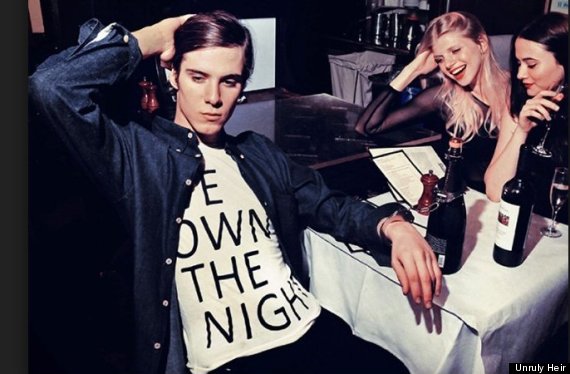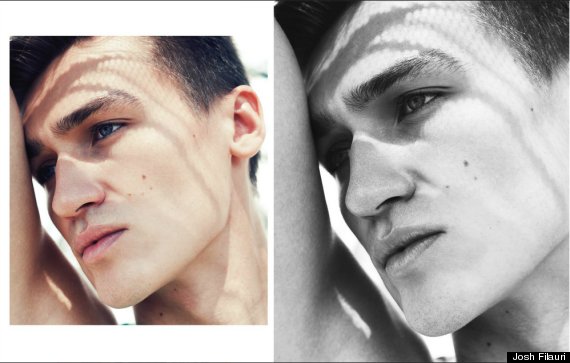
The year was 1991. A Boston-bred street kid known as Marky Mark shot an underwear campaign that left little to the imagination. The client was Calvin Klein, the photographer Herb Ritts, the body as chiseled as Adonis and the face bad-boyishly handsome. And so, the male model was born.
Up until this era, male models were used mainly as props or accessories to the female models, who, during the days of disco, amidst a feminist revolution and the economic boom of the 1980s, sat at the helm of the cult of beauty. Millions of consumers began to worship these women and the lifestyles they represented, and for good reason. By 1990, a year before Marky Mark "dropped trou" for the cameras, the world recognized the most famous female models as "super," not only for their preternatural beauty and notoriety, but for the fiscal control they had over their careers and the industry. (This benchmark in model history is perhaps best summed up by Linda Evangelista's now infamous quote, "We don't wake up for less than $10,000 a day.")
Fast forward 20 years, and it's not just incredibly beautiful women who are making a dime off their pretty faces and lithe bodies, but men as well. Before you dismiss this piece as a an homage to symmetrical bone structure and a well-used gym membership, let me disclose to you my reasons for investigating the world of male models. (Disclaimer: I'm not going to lie, I did enjoy my "research," which consisted of interviews with a dozen New York-based male models, leading me to discover that one becomes more beautiful by association, but that is another article completely.) However, more than my vain proclivities, I was struck by the idea that male models experience what non-model women experience on a daily basis; namely, judgment on their looks in an overt and unforgiving manner. And while there's a case to be made that attractive people in general have it easier (more social, economic, even political opportunities) than the average Jane or Joe, there's also evidence that being beautiful comes with its own Pandora's Box. By now, we are all keenly aware of how female models are ravaged by life-threatening eating disorders and how this trickles down into the lives of women who are forced by the omnipresent idealization of beauty to emulate the billboards, commercials and campaigns that try to sell us more glamorous, sexy and therefore meaningful lives. But what about the men in the same industry?
Are they faced with the same pressures of being a "product"? How do they internalize the demand to be "picture-perfect"? And what about the stereotype that they are brainless mannequins? What toll do these notions take on their self-esteem? In an anecdotal fashion, I answer the above queries and delve into how these male models respond to on-the-job sexual pressures, how it feels to be objectified, how they process anxiety, how modeling has affected their ability to be intimate with others and how they relate to women. So, again, I'm no Marie Curie, but I have infiltrated the world of male modeling, and this is what I've (anecdotally) learned.

1. Even the most handsome men can be insecure about their looks. "Not every day you're going to feel confident," says Charlie Himmelstein, 23, who has modeled for a variety of agencies, campaigns, is the face of Unruly Heir, and is currently making the transition into full-time photographer at Chaos Magazine.
Things like skin, mood and outfits can make you feel bad. The trick is to have clothes that you like, have a good shower and make yourself super clean. Shampoo your hair twice, shave, brush your teeth -- put a conscious effort into making yourself look good. Then have a conversation early in your day with someone you don't know; this gets you ready to socialize with anyone. You can also talk to someone you know admires you. The secret to being confident is being confident.
Robert Ballard, 22, a model with CLICK says, "The first year of modeling was really hard on me emotionally. If I didn't get booked, I'd get hyper-critical of myself and not know how to deal with the rejection. I'd be skateboarding and then all of a sudden I'd start crying and get depressed." And Misha Lukianov, 23, a model with Wilhemina Models, who moved from Russia to New York upon being scouted, sometimes can't even look at the photographs shot of him. "How I see myself is not how other people see me. Every time I see photos from a shoot, I don't like them. I'm very self-critical and they never come out as I expected."
2. Male models are susceptible to eating disorders and body dysmorphia, just like women. Aaron Johnson, 31, currently a DJ and looking to get back into the modeling industry (he was formerly with Q Management) speaks out about what he now identifies as an eating disorder.
The entire time I was working as a model full-time, I was extremely thin. The bone thin 'heroin-hipster' look was my whole shtick. One day, I was on a shoot that featured a very thinly knit fabric that's meant to hang off your body, but for some reason didn't hang as well as it was meant to. It was that very day that I realized I was starting to get a little bit older and that my metabolism was beginning to catch up with me. I was very heavily involved in nightlife at the time, and DJ-ing four nights a week or so for more than six hours a night, and with that came a lot of drinking. Without realizing it, I had developed a beer gut. Unconsciously, I wouldn't eat during the day and save my calories for my nocturnal drinking, but I guess I still put on weight. On the day of the shoot, the photographer and assistant kept telling me to suck in my stomach (and actually to walk around like all the time to lose the gut) but the client was unable to use any of the shots. He actually had to set up an entirely new shoot with a different model. That was one of the worst feelings I've ever experienced.

As for other models, Lukianov hits the gym twice a day for a minimum of two hours, five times a week, doing tons of cardio. As for his diet, he eats small meals every three hours and excludes sweets, carbs and alcohol. A model who did not want to be identified admitted to using Adderall on a daily basis, especially during Fashion Week when he attends up to 10 castings per day. "I don't like the way it makes me feel, jittery and high, but it curbs my appetite so I don't even think about food." On a less extreme scale, Ballard admits to beauty tricks to give the illusion of a more aesthetically pleasing body. "I find if I shave my chest," he says, "it looks more defined."
3. Male models struggle to be taken seriously. From the glass ceiling to the failure of the Equal Rights Amendment, women have long faced the dilemma of working in a man's world, where they are constantly under pressure to prove themselves. Some male models experience the same negotiation of power, which in turn affects self-esteem and a desire to change the way other people perceive them. Johnson explains:
For the most part, the biggest pressure I felt was ever being taken seriously. I think there's a bigger comparison to draw between male models and the way women are viewed in society when it comes to this. Anytime I would try to talk about my ideas or ambitions (outside of the modeling industry or party world) I was treated with a proverbial pat on the head and a patronizing smirk. There's such a huge stereotype of male models being brainless, and without question, I've met several that definitely ARE brainless, that I guess after a while people begin to act like you're just a silly little boy.

4. Male models live under constant stress and anxiety. Luca Schmitz, 22, is a model with New York Model Management, and won't deny the constant anxiety living as a model in New York puts on his life. However, he chooses to use this anxiety to his benefit. Here, he explains:
Sometimes castings, go-sees and jobs combined with your regular day can be really stressful. Sometimes you have to be in three places at once or have only minutes to get from one end of the city to the other. Then add in the pressure to perform and make the client happy and it all can be too much at times. Fashion week is that pressure on steroids! Personally I have found a way of using this pressure and stress as an extra motivation by adapting certain rituals like listening to music, tuning out all the other noise and just focusing on what I my ultimate goals. I also stay in the moment by challenging myself to do better and keep smiling! I think in this industry, regardless of male or female, you have to find a way to make stress and pressure work in your favor, almost embrace it.
5. Male models live with unrealistic paradigms of masculinity, even if it's their job to reinforce them. Just as women organize their daily lives around negotiating outdated and unrealistic paradigms of femininity, we must remember that gender is a relational category. Still, it is only recently that our culture has begun to critique the standards that define masculinity as harmful. When it comes to "looks," the success of male models as an industry is attributed to the items they are hired to sell. Items that connect intimately to a man's body, self-esteem and self-articulation are designed to alter a man's appearance for the "better": body-shaping undershirts to conceal a "beer gut," like Spanx's "Compression Tanks" (got to love the military jargon used in naming this product); expensive suits to denote success;skincare designed "Just For Men". With the mass consumption of such items, we are creating a hegemonic beauty standard for men by making the average Joe feel less-than if he doesn't look like the guy in the ad selling him these notions of masculinity.

Let's hear what the faces behind the campaigns have to say about this: Ballard says his family is "completely proud of me when they see me in a magazine, and all my friends think I'm living a dream, which with all the parties, and traveling, I am." A male model who did not want to be identified boldly states, "I may not be in the top 50 models in New York, but I'm definitely in the top 100, and that's because I have more character than 99% of those a** h**** out there. Do I feel masculine? Just ask the girl in my bed. But seriously, I look good because I have the clothes, the products, the styling, the swag. None of this is an accident." Here, this model confirms the "rewards" such a cultivated ideal of masculinity has afforded him.
Still, even though male models are being paid to cater to a changing face and body of masculinity (one that is achieved with certain products), not all of our culture is willing to share the viewpoint of the model quoted above. "Being a male model," says Johnson, "made me incredibly insecure about my masculinity, like I was doing something 'girly,' especially when I'd go back home to Minneapolis. If I never hear the Blue Steel joke again it will be too soon." Male models, it so seems, are at a Catch-22, as even though their job is to brand an ideal masculinity, they might not always be perceived as "real men."
6. On-set chemistry: the real story. As someone with a little experience behind the camera under my belt, especially in shoots that involve showing skin or getting intimate with a scene partner, I can say that the experience is interesting. I was never uncomfortable with anything I've shot, which I think is key in these situations, and saw the experience as simply professional. Still, I'd be lying if I said that on certain shoots, part of me wasn't turned on by the idea of using my body to arouse spectators. Johnson and Himmelstein agree. "It's like you're dating someone for a day," says Johnson about his on-set relationships with female models. "It's fun sharing underlying sexual chemistry and energy with the opposite sex. Who doesn't like flirting? Who doesn't like getting attention?" And on the topic of getting aroused, which for males is hard to conceal, Himmelstein adds, "It happened on a shoot and the [female] model felt [my erection]. I think she kinda liked it." Yet, for some male models, especially those in monogamous relationships, the on-set stimulation is just part of the job. Lukianov, who is in a committed relationship, shares this anecdote: "The other day I was shooting something and I was in a suit and the female model was completely nude. I tried not to look at her so she didn't get uncomfortable. I have a girlfriend so I won't kiss another model. I have to draw lines." And even if he does get turned on, which is often times beyond the body's control, Lukianov says, "It's just for a minute and bottom line is you must respect the job." Ballard has a slightly different tactic. "When I feel myself getting halfway there, I start thinking to myself 'dead puppies. Dead puppies.'"

7. Male models may relate better to women than non-models. We all know that even the girl in the magazine doesn't look like the girl in the magazine, but still, women seem to kowtow to the pressures these idealized images create. Who better to understand the illusion than a male model? Says a male model who prefers to remain anonymous, "I look one way when I wake up, and a totally different way when I'm shooting something. It's really messed with my head because I don't really feel like I'm selling 'me,' but the client's or photographer's image of me." Johnson credits his experiences modeling for opening his eyes to how "women are objectified [more so than men] in normal life."
So, what have I learned from this informal study of handsome men who make a living off their looks? (By the way, most of them have other jobs to supplement the costs of living in New York City.) I fear we're turning into a society that is hyper-critical of looks, regardless of gender. While part of the woman in me thinks it's about time men experience the same type of shame, self-loathing and discontent we can feel for not living up to female beauty standards, part of me is dismayed that this "disease" is spreading to men as well. I've always adored models, partly because I enjoy the fantasy they create; partly because I know the ad is an illusion that for a moment can take me out of the mundane world I live in. But I'm also thankful to be me, where my flaws are no big deal because the only one who really cares about them is me. The more hyper-critical our culture is about looks, the more hyper-vigilant we have to be about tuning out the noise. It doesn't really make me feel any better that men -- models and the billions of men they are appealing to -- have to develop strategies to turn out the noise as well. But that doesn't necessarily mean I won't be watching that Marky Mark commercial on repeat several times today. Just saying.
ALSO ON HUFFPOST:
